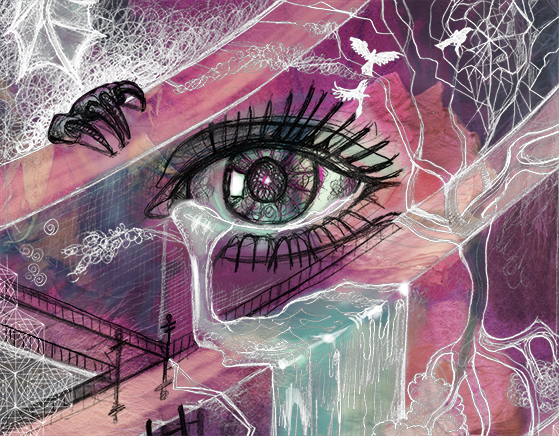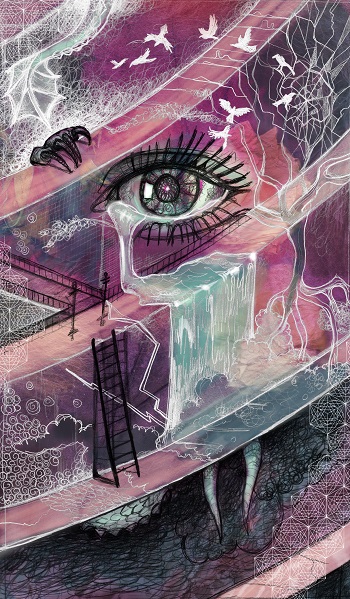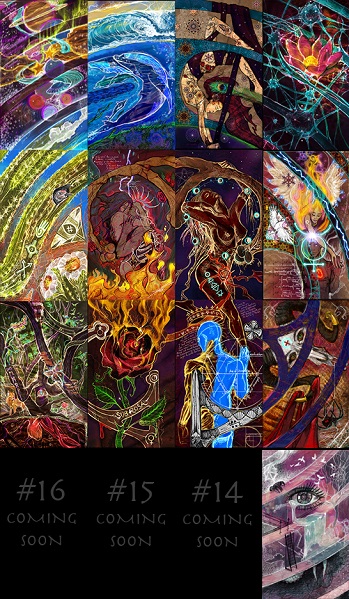The Labyrinth: A Series of Art. {Part Thirteen: Paradox}

Nobody owns the truth. Nobody knows everything. Nobody is capable of that. Yet everybody is, though it’s not what you thought, thus we have the energy of Paradox.
First, I’d like to define what a paradox is. It is a seemingly absurd or self-contradictory statement or proposition that when investigated or explained may prove to be well-founded or true.
Some telling examples that come to mind are religion and science. What I can say in confidence about both groups is that neither one is wrong in their information and beliefs/hypotheses, yet neither one is entirely right. Science can’t have all the answers and neither can spirituality. Yet anomalies still exist, and profound truths are all around us waiting to be understood.
Both definitely do have answers. One is a systematic process of numbers and tests, and replication to establish certainty, while the other one is somewhat organic, not guaranteed, and intangible, but both are real, and true, and both of them also have a tendency to dismiss one another.
Time is another paradox, as it can both be measured linearly, and also felt –as we might express in the colloquial a sign of the times. Richard Tarnas, in his book Cosmos and Psyche, expresses, “Whatever is born or done at this particular moment of time has the quality of this moment of time,” regardless of whether it’s art, actual birth, or an idea.
He goes on to say, “In this view, time is characterized not only by the quantity, as in the conventional scientific understanding, but also by the quality, the latter as tangible as the former is measurable.”
Quantitative is what is measured and written down with numbers — your height, your shoe size, and the length of your fingernails. Qualitative is measured by the quality of something — the softness of your skin, the grace with which you run, or the color of your eyes.
One is physical and easily measured with a system, one is spirit-based and subjective, that is to say, it cannot be measured with numbers but by personal feeling. Your personal perspective, which is not wrong or easily able to be dismissed as it’s very real.

I think what best hit home for me was when I was in deep discussion with my boyfriend whose scholarly viewpoints can stand in opposition to my own quite often, which makes for some scintillating and fascinating discussions that have ultimately made me a better person and continue to do so.
But, what I began to see was: it’s not so much about I’m right and he’s wrong, or vice versa, in a ‘this-or-that’ sort of conflict. But more so, about ‘we’re both right, we both could also stand corrected, this-and-that’ idea.
What I take away from these discussions is a hard-to-swallow concept, but at some deeper level, it begins to alchemize, and before long I reinvent a concept that resonates, based on his perspectives merged with my own.
In this case, I’m uniting the paradox of us. However, the trickiest thing I’ve found is that I have have to get out of the way of myself, from an ego-mind perspective. But what is remarkable is that we have the innate power to do something as impossible as fusing a paradox by using our power of feeling in combination with the analytical abilities of the sacred tool that is our mind.
These two things within us are paradoxical in and of themselves, but are there for our ultimate empowerment.
What I have found through this process of working with paradox is that one must implore a constant vigilance against the ego’s need to be right and remain open to being all-knowing.
Embracing things and concepts which may feel uncomfortable, but that push you to be bigger than you are or once were, can feel uncomfortable, yet there is a huge difference in what is uncomfortable versus what is unhealthy, and being pushed to be bigger is not unhealthy.
You have the power to know your limit. Always honor that.
When you unite/marry two opposing concepts, you soon find they both belong on the same coin, and thus the coin, with the two separate images sticking together, becomes something of value.
If you split a coin in half, to separate one side from the other, it’s worthless. Yet, married, they have each other’s back, one side faces the opposite side from the other, and they each see two entirely different perspectives of the world as one thing.
How wonderful they are when they work together as one, each side sees what the other cannot, yet both are the same thing (paradox) — they quite literally, have each other’s back in this regard. We need both these perspectives, because only one side has no value.
Accepting the idea that it doesn’t have to be this or that, and that it can be this and that, is a powerful concept that when implemented makes a person feel empowered beyond measure. Things begin to affect you less. Your judgment of things you do not understand ceases. Emotions flow better and can be used for co-creational effort, instead of victimization leading to depression.
It becomes a sacred reservoir of right-full energy stored up.
Conflict ceases to be volatile, and becomes more diplomatic and thoughtful. I speak all this from firsthand experience. I have measured my own changes, yet only by feeling and seeing my action and re-action happen differently from how it previously did, and consistently so. In this case, I’m seeing noticeably different change, because of repetitive right-fullness.
Numbers, however, aren’t the tool here that defines it, but paradox.
Right-fullness is using your energy in right measure and not swinging too far into emotional reaction or destitute and/or robotic apathy that is completely detached from what it is to be human.
My rhetorical question here is: why do we so easily allow ourselves to be distracted by being right? We are all right in our own right, but we are also wrong too. Being open to being righted is the first step toward a healthy interaction with not only other beings, but also with the world at large, and for one’s own empowerment.
All the terror and conflict that has ever happened in the world, and continues to happen, is because someone, somewhere, wants or wanted supreme rightness. But that’s impossible. Was it/is it worth all the lives lost? Was it, is it, worth all the atrocities committed, so that some person, some political party, some king, some dictator, some religion, could be right?
When you look at this concept, and really sit with it, you see the absurdness of our ego’s gluttony for rightness and how much we have destroyed and hurt one another over this absurd gluttony for rightness. Even scientists get excited to be proven wrong, because it pushes them into another path of knowing.
When you get out of your own way, you begin to see that it is our unique perspectives of the world that marry us with other perspectives into a complete and whole dynamic that adds value and meaning to the world. You do what I cannot, I do what you cannot. In this, we become right-full. But we don’t achieve right-fullness alone — this is part of the paradox.
Quantum physics is a branch of science that has truly riveted me, as it seems to adopt a this-and-that outlook.
It’s a science that encompasses spirituality, founding itself on the idea that, that which is cosmic and mysterious, and more or less unseen, or dismissed by classical science, can also be right, and tangible, and measurable, and that quantum physics is using scientific method to in fact prove some of these things that we otherwise dismissed as woo-woo thinking.
Interesting that spirituality needs science as much as science needs spirituality (the mysterious). If the mysterious didn’t exist, science would have nothing to do. The mystery opens herself to science because of the structure science has created for her to come through. They need each other in order to be known.
But the paradox is also in how we will never get to the bottom of her, the mystery. She reveals one mystery to science, only to induce more mysteries. It’s these glimpses of the mysterious that science is revealing for us that have more or less shared some powerful truths about our true power and mystery — as human beings, being human.
Paradox may be the ultimate answer, as it tends to repeat in on itself, making something right in both perspectives. Like a mirror but also not, moving in perpetual motion, in correct space — in a sense feeding the other opposing perspective, which puts itself back into the paradox, constantly becoming something new, alive and in right-fullness.
Also, when you take a very simple geometrical pattern and repeat it over and over again (sounds like science), then start to add shadow and tone (sounds like spirituality), you start to wonder: is the design coming towards me or moving away from me? Well, simply put, it’s doing both — it is in the constant creative motion that is paradox.

This is an ongoing series by Kristi Stout. Tune in weekly for the next chapter in ‘The Labyrinth’.
If her art resonates with you, and you’d like prints, contact her through her website or Facebook.
